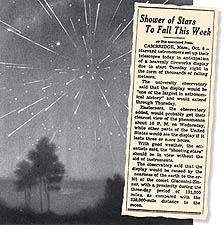|
Astronomy Portal to the Heavens, Deep Sky and Universe
|
|
Night Sky Guide Our knowledge of Astronomy goes back for centuries. Where does one begin learning all this collective information? How much should you understand
before you can begin appreciating the heavens? Here I'll attempt to answer these questions and walk you through a logical progression to understanding the night sky. I'll also provide insight in what equipment is needed to further your enjoyment. Begin by spending time observing the stars with no optical aide. Warm clothes and a lounge chair is all that's needed to enjoy the stars at first. As time is spent under the heavens the sky will reward you with and occasional shooter. Any given night may offer a few these specticles. They are meteors burning up, small fragments of cosmic debris entering the earth's atmosphere at extremely high speed. Each time a comet passes by it leaves a stream of these partices. When the earth moves through the path of these streams we get rewarded with a meteor shower. For times and schedules of meteors visit the American Meteor Society. Most of us have spent time looking at the daytime sky and have been fascinated by the patterns the clouds form. Many times we create mental images with the cloud formations. As we spend time under the night sky we essentially do the same thing. Originally we are awed by the amount of stars and become lost in their share number. After some observing time though the stars begin to form into familiar patterns. Connecting imaginary lines from star to star we begin forming our own mental pictures just as we did with the clouds. Soon these pictures become our easy method to navigate the heavens. Following these imagenary images we then can return to the same stars over and over again. It then becomes easy for us to name the individual stars as they make up our world of make believe. So with this excersise we began our enjoyment by taking in the beauty of the stars. No real knowledge was needed for this intial appreciation. This does though lay out a foundation for our knowledge to build on. The Star Atlas Soon we begin to learn our sky just as men and women did centuries before us. Today though astronomers have used the imagination of our predecessors to form our star charts. The charts are full of the mental images of years ago, now known as the constellations. We are ready then to take our observational knowledge now and purchase our first astronomical aid, the star atlas. See the online sky maps and online shoppping links to obtain these. The star atlas breaks up the night sky into easily digestible bites, known as constellations. The groupings of constellations make up a series of charts which comprise the complete atlas of the sky. For monthly star and planet information check out Sky&Telescopes web pages. As we venture further away from our light polluted homes the night sky opens up into a whole new world of stars. More and more stars become visible in these dark rural areas. The stars become to numerous to count and our familiar constellations disappear into the sea of stars. There is nothing like a dark sky for the experienced amateur astronomer, but for the beginner trying to find there way it is often overwhelming. For now the backyard offers an advantage in presenting only the brightest of stars to the learner. Equipped with a bright star atlas you'll be able to learn the sky quickly. A mistake many beginners make is buying the more advanced atlas which includes the fainter magnitude stars and deep sky objects. Even experience users can get lost with these charts. Purchase the bright star atlas and/or a planisphere. These dials only show the brightest of stars and allow you to quickly locate what constellations are over head any month of the year. As the earth moves through the solar system our seasons change and so does the constellations which are visible.
Related Links American Meteor Society
|
Space Exploration DVDs
| Space Exploration Books | From the Earth to the Moon | Earthlight: NASA - Spectacular Views
|

